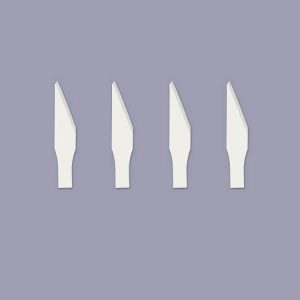
Ceramic surgical blades offer several advantages and functions that make them suitable for various applications in the medical field. Some of these advantages include:
- Sharpness: Ceramic blades can be manufactured to have an extremely sharp edge, allowing for precise and clean incisions. This sharpness can minimize tissue trauma during surgery.
- Chemical Inertness: Ceramics are inert materials, meaning they are resistant to corrosion from bodily fluids and chemicals used during medical procedures. This property ensures a sterile cutting environment and reduces the risk of contamination.
- Hardness and Durability: Ceramics are known for their hardness and durability. This characteristic allows ceramic blades to maintain their sharpness for a longer time compared to traditional metal blades. As a result, they might require less frequent replacements during surgeries.
- Non-magnetic: Ceramic blades are non-magnetic, which is advantageous in certain medical procedures where magnetic interference needs to be avoided, such as MRI scans.
- Reduced Allergies: Some patients may have allergic reactions to metals like nickel that are present in traditional metal surgical tools. Ceramic blades, being metal-free, reduce the risk of allergic responses in such patients.
- Precision and Control: The sharpness and fine edge of ceramic blades provide surgeons with better control and precision during intricate surgical procedures.
Functions of Ceramic Hospital Surgical Blades:
- Incisions and Tissue Dissection: Ceramic blades are used for making precise incisions and dissecting delicate tissues during surgeries.
- Ophthalmic Surgery: These blades are particularly useful in ophthalmic surgery due to their precision and sharpness, where delicate procedures on the eye require utmost care.
- Orthopedic Surgery: In some orthopedic procedures, ceramic blades may be utilized for their precision in cutting bone or cartilage.
- Plastic and Reconstructive Surgery: Ceramic blades are also employed in plastic and reconstructive surgery for their ability to create fine, precise incisions in sensitive areas.
- Dental Procedures: In dentistry, ceramic blades can be used for various surgical applications where precision cutting is necessary.
While ceramic blades offer numerous advantages, they also have limitations, such as brittleness, which makes them susceptible to breaking if subjected to excessive force or bending. Moreover, the initial cost of ceramic blades might be higher compared to traditional metal blades, although their durability and longevity could offset this in the long run due to reduced replacement needs.
